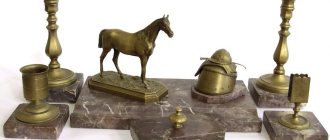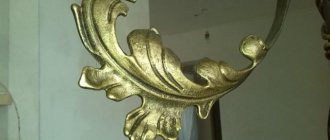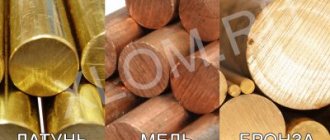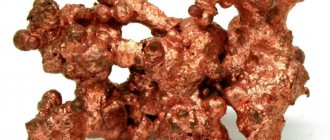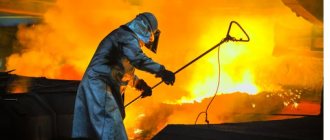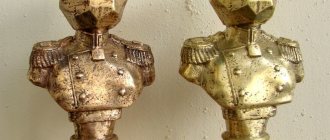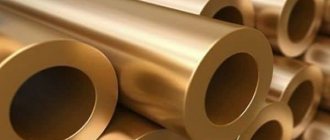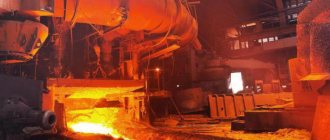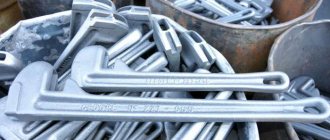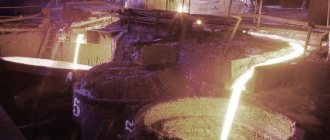Mankind knows many metals and alloys based on them. One of the most famous is brass. This is a copper-based compound to which third-party non-ferrous metals are added. Various parts and elements for electrical equipment are made from this material. Casting brass allows you to make workpieces of various shapes and sizes from it. It can be carried out at the enterprise or at home.
Brass casting
Characteristics and applications of brass
Brass is an alloy whose main components are copper and zinc. The traditional compound is a mixture of 70% of the first metal, 30% of the second. However, there are materials where the zinc content reaches 50%.
To understand how to work correctly with this connection, you need to understand its characteristics:
- Melting point - up to 950 degrees.
- Density - about 8.7 tons per m3.
- Electrical resistance - 0.08 microns per meter.
- Heat capacity - 0.377 kJ/(kg K)
Brass products can be a mixture of copper and zinc, or these two components and additional alloying additives. The alloy is used in various industries:
- production of components for watches;
- creation of figurines, jewelry, interior elements;
- production of parts used in mechanical engineering;
- creation of components for electrical equipment.
Brass has good weldability. In addition, it has a high corrosion protection rate. Due to these characteristics, the alloy is used as a protective coating for other metals in the manufacture of metal structures.
Use in construction and decoration
In construction work, if we mean all finishing engineering work, brass is also used quite often. The most famous area is decorative accessories, since the material is very beautiful in appearance, durable enough for household use and can be easily forged. However, it also has other uses.
Pipes
It is worth immediately noting that in everyday life, in particular for water supply, brass pipes are rarely used. This is due to both the high cost of the material and lower resistance to corrosion compared to products made from pure copper.
The main reason for this choice is the need to achieve a minimum weight of the plumbing system. Such water conduits are made from L-68 brass. They are made by pressing and cold rolling, since the alloy is a two-component alloy, and are well deformed just at low temperatures.
Special-purpose pipes are of much greater importance for the national economy. Their qualities, and, therefore, their application are determined not only by the composition of the alloy - alloying with nickel, manganese, iron, but also by the manufacturing method.
History of technology
Historians say that brass appeared simultaneously with bronze. Alloys were used to make jewelry, tips for tools, weapons, dishes, and cutlery.
To make any item, you had to know the technology of brass casting. Over time, the method developed and improved. Today, the material can be made at home or in production. To do this, you need to accurately carry out the technological process, follow the rules, choose the right tools and raw materials.
Product made of brass
Brass casting - alloys
LTs14K3S3; LTs37Mts2S2K; LTs40Mts3Zh; LTs16K4; LTs38Mts2S2; LC40S; LTs23A6Zh3Mts2; LTs40AZh; LC40SD; LTs25S2; LTs40Mts1.5; LC30A3; LTs40Mts3A; LA; LKS; PM; LAZHMts; LMcJ; LSD; OK; LMcS; LK1; LMcSK; LK2; VOC; L59; L70; L96; LAN59-3-2; LKS65-1.5-3; LO60-1; LS59-1; LS74-3; L60; L75; LA77-2; LANKMts75-2-2.5-0.5-0.5; LMts58-2; LO62-1; LS59-1V; L63; L80; LA85-0.5; LZhMts59-1-1; LMtsA57-3-1; LO70-1; LS60-1; L66; L85; LAZ60-1-1; LZhS58-1-1; LMsh68-0.05; LO90-1; LS63-3; L68; L90; LAMsh77-2-0.05; LK80-3; LN65-5; LOMsh70-1-0.05; LS64-2.
Subtleties of technology
The technology of artistic brass casting is similar to the production of bronze products. It has some subtleties that should be discussed before starting to work with materials:
- Before making a casting, it is necessary to select consumable metals and melt them. For this, different types of ovens are used. Due to the low melting point, you can make a structure for melting yourself. It will consist of a gas burner and a heat-resistant container.
- An important stage during the manufacture of products is pouring the molten raw materials into a mold prepared in advance. The duration of the procedure is no more than 2 minutes. If pouring is done incorrectly, the product may end up with slag pits, burns, depressions, and joints. The finished part will be damaged or require additional processing.
- The alloy must be cooled evenly, without the use of coolants.
- The part requires additional processing after removal from the mold. After casting, sprues, fills, vents, and profits remain on it. They need to be removed.
We must not forget that forms are reusable and disposable. From the first, the workpieces are removed using pliers. The second ones are broken with a hammer.
We take a sheet and make it out of it. All
A little more about technology. What can be made from sheet copper, brass, etc. What is clear and understandable for experienced people is often a revelation for beginners. I think they will complement me and it will be a useful selection. It is clear that one cannot know everything.
Shaping methods may be different. Not the easiest, but very effective - pressure on a lathe. You can press as if enveloping the punch, or you can push the sheet into the matrix. Based on the task, we sharpen the mandrel; the material of the mandrel is wood, plastic, metal. Not very deep copper extraction can be done on wood. It is better to do deep and precise work on a polished steel mandrel.
Simple work can be done with hardwood by lubricating it with thick grease or soap. Preference should be given to wood with not pronounced layers of beech, maple, hornbeam. We clamp a rod with protrusions-stops for a push stick into the tool holder and work with the stick as an oar in a rowlock. More critical work is best done with rollers that match the shape and size of the future product. Often, ball bearings of suitable diameter are used as rollers, which can be mounted both in the fork and on the side, and simply by placing it on a suitable bolt. The holder is attached to the place of the cutter, we clamp any suitable rod on the other side of the tool holder, relax the tool holder and press on the workpiece with a lever - with a rod. You can simultaneously use the calipers to select the point of application of force.
In addition, it is useful to have a iron; you can make several different ones from old files or needle files. The pobedit irons are especially good; they are hard to make, but the work will pay off later. The beauty of Pobeditovs is that they never catch material, neither soft copper, nor silver, nor especially brass, even when dry. Steel tools need to be lubricated, well with natural wax or modern model wax. In addition to shaping, Pobedit irons are good for polishing both when rotating the product on a machine, and simply by applying mirror strokes back to back with your hand. You can repeat the movements in the transverse direction. With a little experience, everything will be clear. You will no longer have unpolished areas due to the inability to reach the polishing wheel. The following photos show items that required precision and repeatability. The mandrels in this case were made of steel, the surface was polished, cylindrical-looking surfaces have a taper, otherwise it can be very problematic to remove the finished work from the mandrel, this must be remembered.
Separately, it is worth dwelling on the production of ring clips. the workpiece is a ring, we press it to a mandrel in the form of the end of a thick pipe with an auxiliary cylinder (can be made of hard wood) and roll the outer part of the workpiece onto the mandrel. If you need precise corners, use a bearing roller. Before rolling the inner cylindrical surface, we fix the finished outer surface with tape or a clamp. Scotch tape is less reliable, but much safer. First, we gently push the material into the sleeve, then we form a clear edge with a bearing sitting cantilevered on the mandrel. The glasses are made of three parts and soldered with POS-45 solder. After finishing - galvanic coating. In the following photos there are castes for round stones with a diameter of 15 mm and 40 mm.
A cylindrical saucepan on a rigid frame is first rolled out. Then we sharpen an accurate mandrel from hard wood, put the pan on, and press the tailstock with the center through the spacer. We start with a roller and end with small presses and irons. To remove the finished part, we bore the wood inside the part and, separating it with a cutting tool, break out the remaining barrel. There were multiple attempts to make such a barrel from a soldered tube, but it only worked from a sheet. The seam does not hold up, apparently the problem is the difference in the hardness of the seam and the rest of the metal. You can also roll gears in much the same way as regular knurling. To do this, you need to find a steel gear that is not large and has the required tooth. You can also roll the gear rack.
What is required for casting?
To melt brass, you must initially prepare equipment and tools for the work. This includes:
- Molding compositions. Made from fireproof materials. The shape is selected depending on the required finished product.
- Special tongs used to make it are removed from the molds after hardening.
- Heating equipment. You can use a purchased model or make a stove yourself. For assembly you will need fireclay bricks and fireproof mastic. For heating, you can use a gas burner or nichrome wire.
- A crucible is a container that is filled with consumables. They melt when heated. Then the master pours the molten metals into a mold prepared in advance. The crucible is made of clay or graphite. Additionally, heat-resistant coating is used, which increases the durability of the container.
In order to remove the crucible from the furnace, semicircular tongs are used.
Jewelry casting at home for beginners
But how are we going to fuse paraffin onto a ring when it is incredibly fluid and unpredictable? It turned out that everything is much simpler. In the process, the master realized that paraffin remains plastic for a long time and can be deformed like plasticine. And so it happened. He simply molded the desired ring shape and continued. True, it wouldn’t hurt to go through a soldering iron in order to fuse the molded boundaries. But the master decided not to do this. Later on the castings this will appear as a defect, but not so bad that you can’t wear this ring. Now we need to process the molded model. The master decided to do it with sandpaper, but he doesn’t remember whether it was forty or sixty, but it was definitely very rough. And again for good reason. The fact is that a large grain of sandpaper leaves a deep mark on the paraffin and gives it texture. Therefore, carefully walking along the front part of the ring with coarse sandpaper, we will leave the resulting texture for casting. Since the paraffin could fail at any moment, the master decided to leave the finishing work to the brass casting.
We put the model aside and prepare the bases for fixing the model. The simplest thing is to make it from plasticine. We knead it and sculpt a hemisphere into which we will install sprues in the future, and subsequently this sphere will become a kind of pocket for melting metal before pouring. Therefore, you should not make the sphere too flat. It is necessary that all the molten metal fits in it. By the time of casting you will understand everything and see for yourself what it looks like.
As a flask (a metal mandrel for pouring the molding mixture), you can take a very ordinary metal pipe; for example, a plumbing store should have pieces of a suitable size.
We will make the sprues from 2 nails. We bite off the excess with pliers and install them in our plasticine sphere. After installing them, we somehow need to attach the wax model to the metal sprues. To do this, the author decided to take a burner and slightly heat the nails, and then lean the ring against them. Hot nails will easily melt the paraffin and go deep into the model.
And actually, it turned out quite well. When the plaster gets stronger, you can clean the mold from sagging and separate the plasticine from the sprues. Now comes the most crucial moment - the moment of calcination of the mold. In the instructions for the molding compound, there is a map that indicates the calcination cycle of 15 hours. But since this goes against knee technology, it would be fair to reduce this time to 40 minutes.
This is bad and wrong, but still possible. The main thing here is to provide gentle heating at first, so that the water from the plaster begins to evaporate, and the paraffin begins to smoothly melt and flow out. The master used a roofing torch for this, since he had one. You can get by with a household burner, or you can start with a very ordinary oven, it will be more correct. Just don’t forget to place the mold with the sprues down in some kind of tray so that there is somewhere for the paraffin to drain.
You can pour metal at home in several ways: using potatoes, clay, or any other dense, moisture-containing material. But the author has never mastered this method, so he will cast metal using a manual centrifuge.
It looks like a glass with four bolts (for more reliable fixation of the flask), a chain and a handle made of PVC pipe with bearings inside (for long-term unhindered torsion).
The author welded this thing himself, but you can get by with, for example, a metal mug.
We heat the mold until red and prepare to pour the brass. As a starting material, you can take brass plumbing fittings. They're great for this. Well, or if you are braver, you can immediately pour silver or even gold. There are no restrictions on metal in knee technologies.
Preparatory work
Before you start making a casting, you need to prepare for the main work. Initially, you need to develop a sketch of the future product and sketch it on paper. Using the finished drawing, make a mold for pouring the molten alloy. It is made from clay and quartz sand. There are reusable and disposable forms. The former are more difficult to produce, but they can be used in the serial production of products from metal alloys.
After the brass part is manufactured, additional processing will be required to eliminate defects that occur during casting. For this purpose, the casting surface is subjected to chemical treatment. Using active solutions, defects are removed from the surface of workpieces.
Casting surface
Brass casting - chemical composition of popular alloys
| Name | Alloy | Cu | Fe | P | Pb | Zn | Sb | Bi | Si | Mn | Ni | Al | Sn |
| Brass casting | L63 | 62 — 65 | 0,2 | 0,001 | 0,07 | 34,5 — 38 | 0,005 | 0,002 | — | — | — | — | — |
| Brass casting | LS59-1 | 57 — 60 | 0,5 | 0,02 | 0,8 — 1,9 | 37,35 — 42,2 | 0,01 | 0,003 | — | — | — | — | — |
| Brass casting | LTs23A6Zh3Mts2 | 64 — 68 | 2 — 4 | — | 0,7 | 16,2 — 28,5 | 0,1 | — | 0,3 | 1,5 — 3 | 1 | 4-7 | 0,7 |
| Brass casting | LTs38Mts2S2 | 57 — 60 | 0,8 | 0,05 | 1,5 — 2,5 | 32,8 — 40 | 0,1 | — | 0,4 | 1,5 — 2,5 | 1 | 0,8 | 0,5 |
| Brass casting | LTs25S2 | 70 — 75 | 0,7 | — | 1 — 3 | 19 — 28,5 | 0,2 | — | 0,5 | 0,5 | 1 | 0,3 | 0,5 — 1,5 |
| Brass casting | LTs40S | 57 — 61 | 0,8 | — | 0,8 — 2 | 35 — 42,2 | 0,05 | — | 0,3 | 0,5 | 1 | 0,5 | 0,5 |
Foundry models
Artistic casting of bronze and brass involves obtaining the smoothest possible surface, so fairly hard materials are used to recreate the model:
To obtain the smoothest possible surface, it is subjected to elimination of porosity by puttying, priming and varnishing. Casting models are made split; one-piece - suitable for casting products of simple shapes; special for parts with a rather complex configuration.
For multi-component temperatures, the temperature regimes increase to 895 °C - 1070 °C due to the introduction of alloying components with a high melting point.
Description of technological operations
The injection molding process is carried out in steel molds. The molten material is fed into the mold and crystallizes there under high pressure.
A mold is a technological casting equipment constructed from movable and fixed steel parts. The movable half moves along guide cylinders, the fixed half is fixed on a stationary plate.
Before pouring, the moving part is pressed tightly against the stationary part by a hydraulic cylinder and fixed in this position with special locks. After the workpiece hardens, the moving part of the equipment moves away, and the casting is pushed out by mechanical pushers. Before closing the mold, the surfaces in contact with the molten metal are coated with a release agent. The special composition ensures smooth separation of castings after casting and protects the steel from the negative effects of high temperatures.
Injection molding is performed automatically in industrial plants. The main unit of this equipment is the pressing chamber; it can be cold or hot. The cold chamber is a horizontal cylinder with a piston inside and a funnel designed to pour in the melt. After pouring the metal, the piston moves inside the cylinder, pumping the melt into the mold. After filling the mold, the force on the piston increases to create sufficient pressure to crystallize the metal.
The hot pressing chamber is a molten bath located in a heated cast iron crucible. The forward movement of the piston pushes the melt out of the crucible. The metal rises through the channel and enters the mold. The channel design includes a heated mouthpiece. This element is needed to prevent the liquid metal from solidifying inside.
After the part has solidified, the remaining melt from the channel is drained back into the cast iron bath. Equipment of this type is used for products made of zinc and magnesium alloys.
Melt heating temperature
Heating of the material for injection molding is carried out based on the grade of the alloy and the geometric parameters of the part. If the melt is overheated, when filling the mold, splashes enter the ventilation holes and clog them. This leads to deterioration of the gas outlet and, as a consequence, to the appearance of pores in the casting.
The high temperature of the liquid metal leads to an increase in the solidification time of the product, as a result, more time is needed for the entire technological process. Equipment wear increases due to prolonged contact with the superheated melt. The danger of welding the poured metal to the equipment increases, which can cause damage to the part when being pushed out. All this leads to rapid wear of the mold.
In injection molding, the melt is compressed at a minimum temperature. Non-ferrous metals are heated only 10–300ºС above the temperature at which the alloy completely hardens. With small thicknesses of casting elements, the alloy must be heated more strongly. To cast large products with simple configurations, the alloy is heated just above its melting point.
For parts that have high strength requirements, the metal is poured in a solid-liquid state. This provides the following benefits:
- prevent the appearance of shrinkage defects in the casting;
- reduce thermal impact on equipment;
- reduce the cooling time of the product;
- reduce the risk of welding of the mold and casting.
Metal with inclusions of the solid phase can be pressed only in installations with a cold chamber. When using equipment with a hot chamber, there is a risk of melt solidification in the supply channel.
An example of injection molding of aluminum parts is the percentage of solid particles in the melt, when the mold is filled smoothly and the quality of the casting remains at a high level, ranges from 40 to 60%.
Melt feed rate into the mold
The piston compresses the metal into the mold at a certain speed. The value is selected depending on the characteristics of the alloy and the geometric parameters of the casting. If the product is simple with thick walls, high pressing speed is not needed. If the part has complex geometry and thin elements, the pressing speed must be high. This is required so that the melt has time to fill all narrow cavities before solidification.
Too high a flow rate of molten material causes the following phenomenon: the jet will split into small droplets, forming a mixture of melt and air. If the number of channels for exhaust gases is insufficient or they are clogged with metal, air bubbles will remain in the casting. This will lead to the formation of pores in the metal; to eliminate such defects, the mold is placed in a vacuum.
The quality of castings and the durability of equipment depend on the speed of movement of the melt. If the injection molding speed is too high, the protective lubricant may be washed off from the surfaces in contact with the liquid metal. This will cause the casting to weld to the mold and may damage or break when pushed out.
Feeding too slowly will reduce the quality of the part. The metal will solidify while the mold is being filled before the force is increased. The speed at which the melt enters the mold during injection molding is usually selected in the range from 10 to 50 m/s. Low speed is used for casting parts made of steel and copper alloys; high speed is required for tin and zinc alloys.
Pressure on the melt during solidification
At the moment when the melt completely fills the mold, the force on the piston increases many times. The pressure does not stop until the metal has completely hardened. As a result, the density and mechanical characteristics of the casting increase, and shrinkage defects do not form in it. With increasing compression force, the number of defective products decreases, the cleanliness of the metal surface increases, and the quality of castings improves.
The higher the requirements for the strength of the part, the greater the pressing force must be. Aluminum alloys are pressed at pressures from 40 to 200 MPa. For magnesium-based alloys, from 40 to 180 MPa are used. Zinc alloys are subjected to pressure from 10 to 50 MPa. To ensure high quality, as the wall thickness increases, the pressure during crystallization must be increased.
Mold heating temperature
Before feeding the liquid alloy, foundry equipment must be heated to a certain temperature, which is selected for each alloy depending on the wall thickness of the product. Mold preheating temperature:
- for zinc casting up to 120–1600 ºС;
- magnesium 200–2400 ºС;
- aluminum 180–2500 ºС;
- steel 200–2800 ºС;
- brass 280–3200 ºС.
If the casting is thin-walled, the mold is heated to a temperature closer to the higher values of the above intervals. For thick-walled parts - closer to the lower value. This is necessary so that in thin-walled castings the melt does not harden during the filling of the mold. In the technology of pouring large parts, on the contrary, it is necessary to increase the solidification speed.
Bronze casting: artistic bronze casting technology
Bronze casting allows us to produce products that have exceptional decorative appeal. The technology of casting from this alloy, which is based on copper, has been known for many centuries, but even in our time it continues to be improved.
The appearance of bronze products speaks of the painstaking work of the master, turning faceless metal into a work of art
